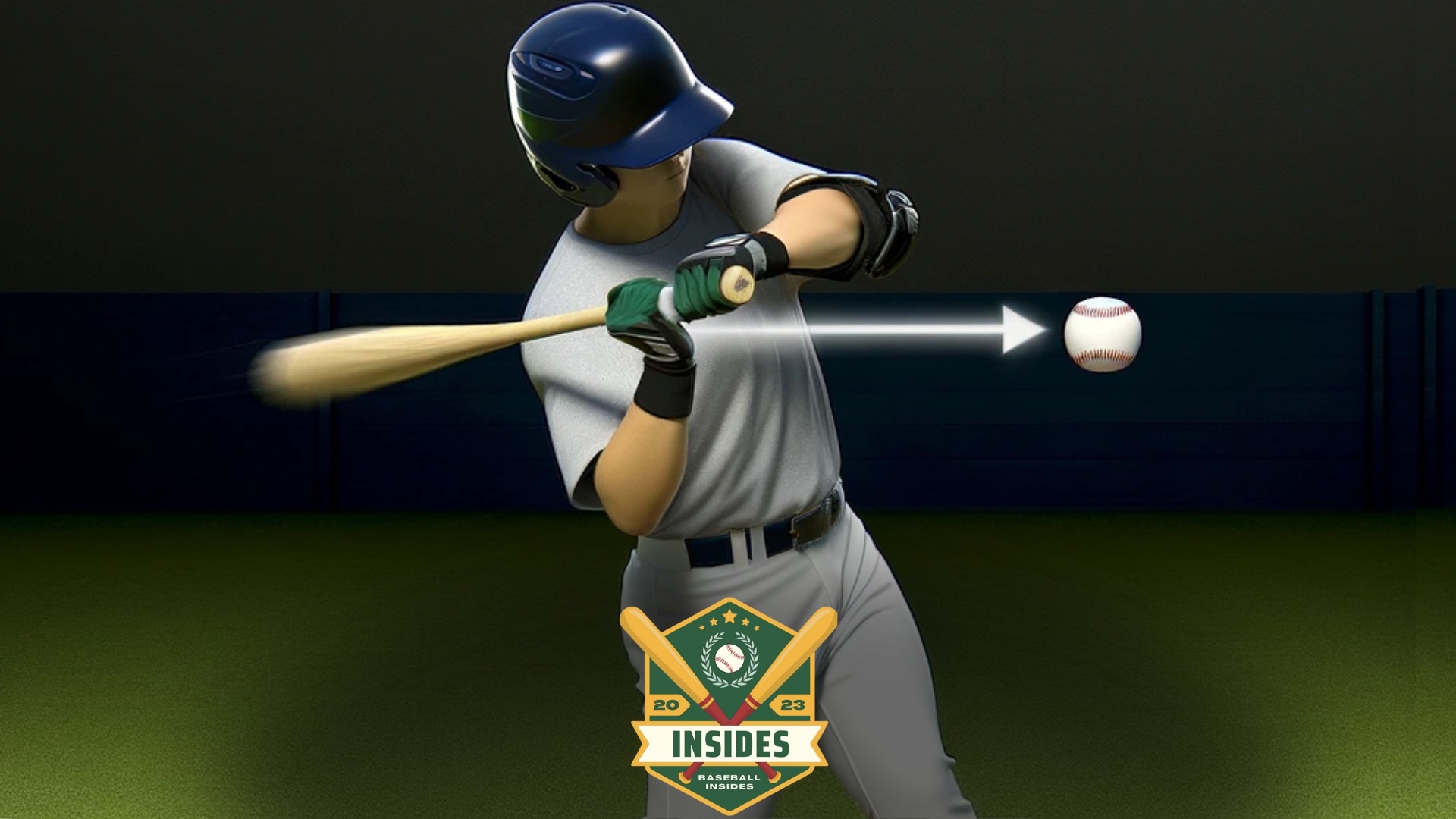
In this article:
In baseball, it’s generally advised to swing the bat in a slightly upward path. Swinging level is a common misconception that can limit power and effectiveness.
The technique behind batting in baseball is a topic of much discussion among players and coaches. A level swing is often touted as a fundamental aspect of hitting. Still, experts suggest that a slight upward angle at the point of contact can maximize power and improve the chances of making solid contact.
This approach helps elevate the ball, leading to more line drives and home runs. Understanding the mechanics of a swing can dramatically affect a player’s batting average and overall performance.
Proper swing technique is crucial for players at all levels, from Little League enthusiasts to professional athletes striving for excellence in their batting skills.
Tailoring the swing to make the most of each pitch can lead to remarkable results on the field.
Myth vs. Reality: The Level Swing Debate
One hotly contested topic in baseball circles is the concept of the level swing. Many coaches and players swear by the effectiveness of keeping the bat level through the strike zone. But what does the evidence say?
As we dig into the historical perspectives and the current understanding of hitting mechanics, it’s clear this debate isn’t simply black and white.
Historical Perspectives on Batting Technique
For generations, the idea of a level swing has been passed down from seasoned veterans to young rookies.
The common belief was that keeping the bat level would enable hitters to keep the bat in the hitting zone longer, thereby increasing their chances for contact.
Coaches emphasized a swing that paralleled the ground, aiming for consistency and control.
- Babe Ruth is often cited for his level swing despite many photos showing a distinct uppercut.
- Ted Williams argued for a slight uppercut to match the plane of the incoming pitch.
In the past, the prevailing wisdom centered around a simple, repeatable motion that could be easily taught and replicated.
Evolving Theories in Hitting Mechanics
Today’s understanding of hitting mechanics takes a more nuanced approach. Advanced analytics and high-speed video have shown that the swing path of successful hitters often isn’t perfectly level.
Notable points include:
- Launch angle, exit velocity, and bat speed are now critical metrics in hitting performance.
- An uppercut swing is sometimes encouraged to increase power and launch angle.
| Old Belief | New Understanding |
|---|---|
| Level swings maximize contact. | Variable swing paths can be adjusted based on pitch location. |
| One-size-fits-all swing technique. | Swings should be tailored to a hitter’s strengths. |
The modern swing is a dynamic movement that can change depending on the situation, allowing hitters to adapt and thrive in a rapidly evolving sport.
Physics of the Swing: Understanding Bat Path
Baseball swings are more than just hitting the ball. They combine art and science. The bat path is key to a successful swing. It’s the arc the bat travels through the hitting zone.
A well-executed bat path can mean the difference between a foul ball and a home run.
Role of Angles in Batting Success
The angle of the baseball bat during the swing matters a lot. Proper angles can help hitters make solid and consistent contact with the ball. Aim for a slight upward angle.
This helps meet the ball as it descends from the pitcher’s hand to the plate.
- Launch angle: This is the angle at which the ball leaves the bat. It affects how far and high the ball will go.
- Attack angle: The angle the bat takes when it hits the ball. A good attack angle can lead to more powerful hits.
Impact of Swing Trajectory on Ball Velocity
Swing trajectory is the bat’s path. It can affect the speed at which the ball leaves the bat or the ball’s velocity. For maximum velocity, the swing should match the pitch’s angle.
A level swing can lead to grounders. An upward swing trajectory can produce more fly balls. Players need to find a balance.
A slight uppercut swing trajectory tends to be the most effective. This increases both the chance of contact and the ball’s exit velocity.
| Swing Trajectory | Resulting Ball Type |
|---|---|
| Flat | Grounders |
| Uppercut | Fly Balls |
| Slight Uppercut | Line Drives/Home Runs |
Biomechanics Behind an Effective Swing
Understanding the biomechanics behind an effective baseball swing is crucial for players and coaches. It involves complex motions and precise timing.
A proper swing is not purely a level motion; it’s a fine-tuned blend of strength, speed, and mechanics.
Anatomy of a Power Hitter
To unlock the secrets of a power hitter, one must dive into the human anatomy.
- Core strength: A robust core stabilizes the body, providing a solid base for the swing.
- Lower body power: The legs drive the initial force for the swing.
- Upper body dynamics: Shoulders and arms transfer and amplify the force to the bat.
| Body Part | Role in Swing |
|---|---|
| Legs | Drive force |
| Hips | Rotate to generate speed |
| Core | Connect lower and upper body movements |
| Arms | Direct the bat’s path |
Coordination and Timing Essentials
The swing in baseball is an art of coordination and timing.
- Eyes on the ball: Vision guides the body’s motion.
- Hip rotation: It begins the kinetic chain for the swing.
- Sequential movement: Each body part acts in harmony.
Effective timing ensures the bat meets the ball at the right moment. Mastery of these elements leads to a well-executed swing.
Evaluating Professional Hitters’ Approaches
Evaluating Professional Hitters’ Approaches in Baseball unlocks a treasure trove of insights. Baseball enthusiasts and aspiring players often wonder one thing: How do professional hitters swing? Is it level, upward, or downward?
In this deep dive into the techniques of pro batters, we reveal the nuances that make them successful.
Case Studies: Famous Batters and Their Techniques
Expert hitters have refined their swings over countless at-bats. Let’s look at a few game-changers:
- Ted Williams: He preached for an upward swing, revolutionizing hitting strategies.
- Ichiro Suzuki: A master of bat control, his technique emphasizes a level swing for precise hits.
- Barry Bonds: With a blend of level and uppercut motion, Bonds generated unparalleled power.
Each player adjusted their swing for peak performance. The trend? There’s no one-size-fits-all approach.
Comparative Analysis of Swing Patterns
Analyzing swing patterns presents a diverse landscape. Here’s how different swings stack up:
| Swing Type | Pros | Cons | Famous Proponents |
|---|---|---|---|
| Level Swing | Consistent contact, better bat control | May limit power | Ichiro Suzuki, Derek Jeter |
| Uppercut Swing | Home run potential, high exit velocity | Higher strikeout rate | Ted Williams, Barry Bonds |
| Downward Swing | Ground ball focus, lower strikeouts | Less extra-base hits | Tony Gwynn, Wade Boggs |
In contrast to swings, a level swing offers control, an uppercut maximizes power, and a downward angle ensures play consistency.
Each pattern has shaped the legends of the game.
Training Regimens for An Optimal Swing
To achieve a level swing in baseball, dedicated practice is crucial. Drills and technology assist players. They refine the mechanics of their swings.
Let us guide you through effective methods to sharpen your swing for that perfect hit.
Drills to Develop the Right Bat Path
Drills enhance muscle memory, leading to a consistent bat path. Practice these routines for improvement:
- Tee Work: Focus on hitting the ball squarely. Adjust tee height for pitches of different zones.
- Soft Toss Drills: Have a partner toss the ball. Aim for hitting line drives up the middle.
- Batting Cage Practice: Utilize a variety of speeds. Work on timing and swing levelness.
Using Technology to Refine Swing Mechanics
Implement advanced tools for detailed feedback on your swing:
| Technology | Purpose | Benefit |
|---|---|---|
| High-Speed Cameras | Record swings | Capture nuances often missed by the naked eye |
| Sensor Equipped Bats | Gather data | Analyze bat speed, angle, and path |
| Swing Analysis Software | Break down mechanics | Provide actionable insights and corrections |
Integrate these tools during practice sessions. They provide clarity and precision in mechanics adjustment. Your swing can reach new levels of competitiveness.
The Future of Batting: Trends and Predictions
The sweet sound of the bat striking the ball is timeless in baseball. The approach to hitting continuously evolves with advancements in technology and materials.
Innovations in Bat Design and Materials
Bat manufacturing is a field full of innovation. The coming years promise lightweight, sturdy bats that transform hitting.
- Composite materials are shaping the future of bats, improving strength and power.
- Smart bats with embedded sensors offer real-time feedback to enhance training.
These innovations make the bat more efficient and help in consistent swing mechanics.
Emerging Technologies in Swing Analysis
Analysis technology is revolutionizing batting techniques. Players now have data-driven insights to refine their swings.
- High-speed cameras capture swing paths, offering clarity on mechanics.
- Wearable tech tracks player movements, providing detailed performance data.
Coaches can tailor training to a player’s specific needs with these technologies.
Join us as we explore these trends in more detail, predicting how the art of batting might look.
Frequently Asked Questions
How Do You Keep Your Swing Level in Baseball?
To maintain a level baseball swing, keep your head steady, focus on a consistent stance and posture, and practice regularly. Ensure your hands are positioned correctly, and use a smooth, controlled motion to swing through the ball.
What is the Proper Baseball Swing?
The proper baseball swing combines a balanced stance, smooth hip rotation, and a firm wrist snap. Keep your eye on the ball, engage your core, and follow through with your bat.
What is the Optimal Swing Angle in Baseball?
In baseball, the optimal swing angle, also known as the attack angle, is typically between 5 and 15 degrees. This range helps maximize the likelihood of solid contact and driving the ball effectively.
Should a Baseball Swing Finish High?
Yes, a baseball swing should typically finish high, as this helps follow through, generate power, and maximize swing momentum.
What is a Level Swing in Baseball?
A level swing in baseball refers to a bat path that moves horizontally through the hitting zone, parallel to the ground, which helps to make consistent contact with the ball.
Conclusion
Exploring the art of the baseball swing brings us full circle. The level swing debate turns on mechanics, player style, and situational tactics.
Mastering your swing is a personalized journey vital for success at the plate. Practice, expertise, and tailored coaching form the foundation of every great hitter’s strategy.
Embrace the nuances, and you’ll elevate your game above the competition.






